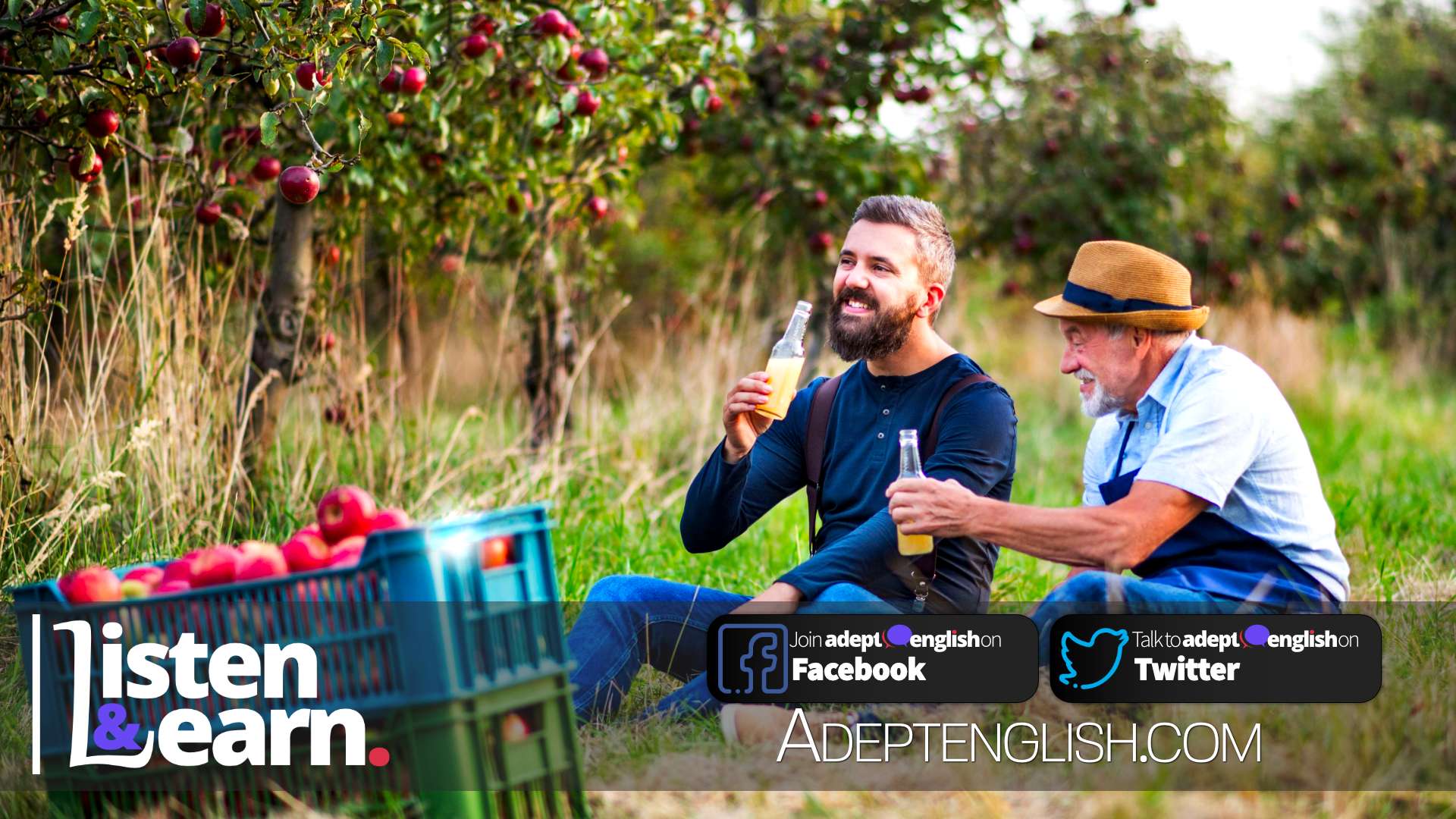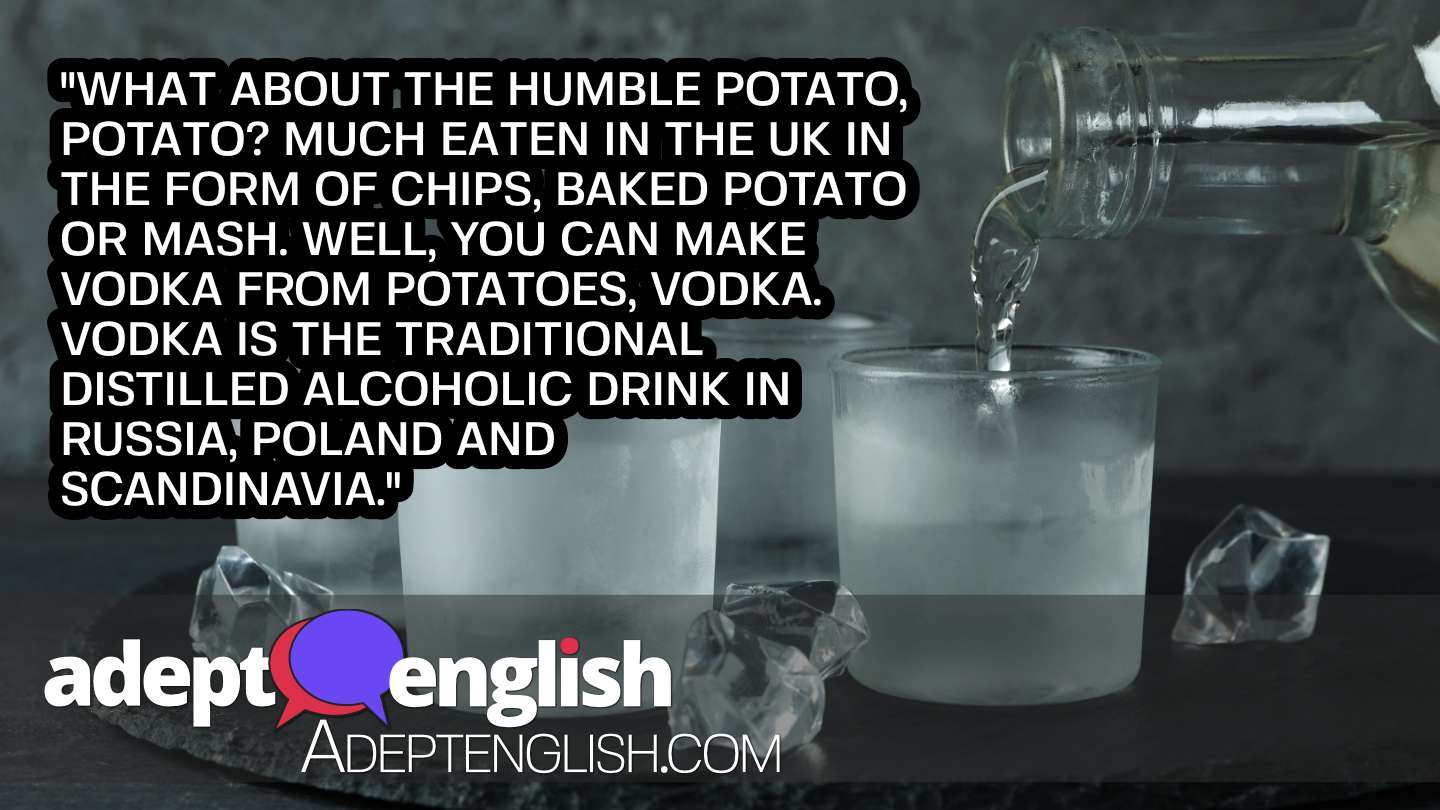Learn English In An Entertaining Way With Our Collection Of Phrases With Alcohol From Around The World
Today we discover what goes into alcohol from around the world as we explore the associated English phrases used in and around alcohol in the UK. There is a lot going on inside this English lesson which uses the Adept English listen and learn approach to learning to speak English fluently.
In this podcast you will listen and learn a few interesting facts about alcohol and in around 10 minutes you will have listened to over 2000 English vocabulary words and hundreds of English phrases. You will hear the correct pronunciation (and all the cadence and intonation associated with speaking in British English!) of words at a pace suitable for language learners and all in a native British accent.
Now if you take this podcast and listen to it repeatedly. Not over and over, but spaced out using a spaced repetition approach. You will encourage your brain to recognise what you are listening to as important. This is key to getting your brain to store what you hear in your long-term memory.
Once you’ve stored all the important language information in your longer term memory. You will notice that your comprehension improves. It’s just easier to listen to English language speakers and pick out the words, the phrases being used. You should notice that you stop translating in your head. You are much better prepared to join in and speak in natural English conversation.
What we do with our listen and learn approach to language acquisition is a process that considers the way our brains work. Our approach is a system of learning that uses the tools we all had as children when we learned our first language. You can learn more about it here. What we do with our listen and learn approach to language acquisition is a process that considers the way our brains work. Our approach is a system of learning that uses the tools we all had as children when we learned our first language. You can learn more about it here.
Most Unusual Words:
Cadence
Grain
Fermented
Gluten
Crops
Cereal
Botanicals
Intonation
Most common 3 word phrases:
| Phrase | Count |
|---|---|
| To Make Alcohol | 2 |
| If You Like | 2 |
| In The UK | 2 |
| Used To Make | 2 |
| Around The World | 2 |
Listen To The Audio Lesson Now
The mp3 audio and pdf transcript for this lesson is now part of the Adept English back catalogue . You can still download and listen to this lesson as part of one of our podcast bundles.Transcript: English Phrases And Alcohol From Around The World
Hi and welcome to this podcast from Adept English. If you like what we’re doing in our podcasts and you enjoy the free English language learning with the podcast, then you can support us, help us by giving us a review.
If you’re an Apple user, then if you select our podcast feed, and then page right down to the bottom of the screen, you can give us a star rating – or even better, write us a review! That would be really helpful to us – we say a big thankyou to anyone who writes us a review or gives us a star rating!
Do you drink alcohol or not and if so, what kind?
After I wrote Monday’s podcast, I did a bit more research on Moonshine, and found myself interested in what different things people have used across the ages and around the world to make alcohol. And I found information which I half-knew, which I thought was interesting. I’m not a big alcohol drinker myself.
I might have a couple of gin and tonics over the course of the week and maybe a glass of wine. Red wine has been my preferred drink for years, but last year I found that even without drinking very much of it, it made my body ache and I felt ill after it – as though my body didn’t like it any more and couldn’t process red wine!
I don’t know if it’s the histamines, but anyway, rather disappointing. But I’ve switched to drinking white wine and that’s fine. And gin and tonic is is still OK too, which is good. We’re currently working our way through the various flavoured gins that we have. Currently we’re on lemon gin and blood orange gin. With a slice of lemon and tonic – very nice!
Alcohol can be made from all kinds of things
But my interest was taken by all the different things that can be used to make alcohol – different plants, vegetables, fruit or cereals are traditionally used to make different types of alcohol around the world.
Some of it I knew, some I didn’t. If you don’t drink alcohol and I know that a substantial number of our listeners don’t, just treat is as ‘general knowledge’. And the podcast today will have you working hard on your vocabulary. I think you may learn some new words for fruit, vegetables or cereal crops as you listen.
Cider from apples, perry from pears
So alcoholic drinks that we make in the UK first of all. Cider, that’s CIDER and it’s made from apples. I love cider, though sometimes what comes out of bottles is a bit sweet and fizzy for me. My preference is for what’s known as ‘scrumpy cider’ – which comes out of a tap in a pub – ‘on draft’, if you like.
Scrumpy can be quite strong – and not fizzy at all. The version of cider that is made with pears, PEARS in the UK, which is usually fizzy is called ‘perry’, PERRY. So ‘perry’ is ‘pear cider’.
Reminder to check out Course One, Activate Your Listening
Before we go further, just a reminder that if you’d like to continue your English language learning in a more structured way – and you’d really like some practice at English conversation, then you can buy our Course One, Activate Your Listening on our website at adeptenglish.com.
Boost Your Learning With Adept English
This course will really help your fluency and your vocabulary and it will help you understand other English speaking voices as well as mine.
Beer from barley and hops
Back to what our alcohol is made from. We also drink a lot of beer in the UK. It’s most usually made from barley, BARLEY – which is a cereal crop. Barley is not much good for other food uses – but it’s great for making beer. And beer is flavoured with hops, HOPS. This is a climbing plant called humulus lupulus and it has green flower heads and it’s these that are used in beer making. What I didn’t know is that humulus lupulus, which is a pretty garden climber, is a member of the cannabis family. For beer, you can also use other cereal crops, like wheat, maize and oats or even rice.
Barley wine and kvass from barley
So barley can be made into beer – or another alcoholic drink I’ve enjoyed in the past – barley wine. Though this drink is called ‘barley wine’, it is actually a beer too. Barley also used when you make kvass, KVASS, which is a non-alcoholic beer-like drink made in Russia. It’s a kind of probiotic, kvass – good for the bacteria in your digestive system.
Whiskey from rye
And if you want to make whiskey, that’s made usually from another cereal crop – rye, RYE. Like beer, whiskey can also be made from wheat or corn or barley – but rye is more usual. You can even make whiskey by distilling beer. ‘To distil’ means to remove some of the liquid, so that the alcohol content is even higher.
Download The Podcast Audio & Transcript
Gin, GIN is also distilled. That’s usually made from wheat or rye as well, as a base, but of course all kinds of other flavours are introduced to gin – usually, famously juniper berries – but all kinds of plant flavours can be used, called ‘botanicals’.
Grapes for wine, champagne, brandy and cognac
And then of course grapes are made into wine in many countries of the world. Wherever it’s warm enough to grow grapes, you find wine and fortified wines and in France, in a certain region, you also find champagne, CHAMPAGNE. But from grapes also comes brandy and cognac, that’s COGNAC. So again, rather like champagne, cognac can only be made in certain regions of France. Martini is also made from wine, fortified or ‘strengthened’ with sugar, extra alcohol and botanicals – or ‘plant flavourings’. So ‘botanicals’ is BOTANICALS .
Video
Rum from sugar cane
What about alcohol from sugar cane or molasses? Well, this is where we get rum, RUM from. So wherever sugar is grown, rum is made. Countries where sugar cane or molasses can be grown are ones in the Caribbean, especially Jamaica, Martinique and Puerto Rico, Cuba, the Philippines, the Americas and India.
Sorghum beer, burukutu, bantu beer and pombe
What about sorghum, SORGHUM? Sorghum is a grain, another cereal crop, GRAIN and that means a kind of seed that you eat. It comes from a grass, which is used in China and across Africa to make beer and which can also be distilled to make stronger alcohol. So sorghum beer is gluten-free, unlike other types of beer.
Gluten, GLUTEN is what people commonly have problems digesting – it’s found in wheat, pasta and bread – so many people need to eat and drink gluten-free. Other African alcohol - burukutu is made also from sorghum – and another seed, called millet, MILLET. And burukutu is popular in countries like Nigeria, Kenya, Burundi, Ethiopia and Ghana. Also made from the seed millet, pombe, POMBE or bantu beer – that’s BANTU beer. This is popular throughout Africa.
Chicha from corn
In parts of South America, you might use corn to make chicha. So this can be fermented, FERMENTED – that means it’s got alcohol in it, or non-fermented, which means it doesn’t and it’s more like a fruit drink. Corn can also be used to make whiskey or gin, as well.
Vodka from potatoes
What about the humble potato, POTATO? Much eaten in the UK in the form of chips, baked potato or mash. Well, you can make vodka from potatoes, VODKA. Vodka is the traditional distilled alcoholic drink in Russia, Poland and Scandinavia. It can be made from cereal crops or grain, but potatoes make good vodka too. Aquavit is the similar drink in Scandinavia – it’s really strong, so you drink it quickly, rather like ‘eau de vie’ in France or schnapps. Aquavit is flavoured with caraway seeds, that’s CARAWAY and citrus peel and spices.
📷
A photograph of a bottle with pouring vodka and shots of vodka on black tray. As we discover English phrases related to alcohol.
Rice for saki
Famously rice is used to make Japanese saki - saki wine. A bit like barley wine – it’s called ‘wine’, but the process of fermenting the rice is more like beer making.
And for tequila – blue agave!
And last one that I just didn’t know, though I have drunk this drink in the past – tequila, that’s TEQUILA as in the cocktail Tequila Sunrise is actually made from the succulent agave! That’s AGAVE and specifically the blue agave. So a spiky, desert plant, a succulent with prickles, that grows in hot places and holds lots of water. And of course it’s from Mexico, ‘Mexico’.
How have I gone so long without ever knowing that tequila comes from agave? I don’t know. Anyway, if you fancy a tequila sunrise, that’s tequila, orange juice and grenadine. Or maybe you prefer hardcore tequila shots with salt and lime?!
Goodbye
Anyway – there you are. Alcoholic drinks of the world – and some of the things that are used to make them. I found that interesting anyway! I hope you did too! And perhaps you’ll have learned some vocabulary for fruit, vegetables, cereal crops and alcoholic drinks. Enough for now. Have a lovely day. Speak to you again soon. Goodbye.








